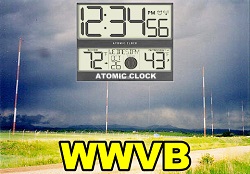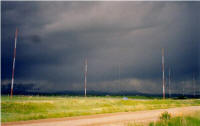|
<Previous
Next > WWVB Atomic Clock Signals
 As is typical for Gary Breed, editor of
High Frequency Electronics magazine, he wrote a great
general interest article about the time and frequency broadcasts put out by the
National Institute of Standards and Technology (NIST) – originally National Bureau of Standards (NBS). His piece
concerned the history of the
WWV and
WWVH signals that have been used since their origin in 1920 by
amateur and professional radio operators to calibrate and synchronize time and frequency
standards. I highly recommend reading the one-page article. As is typical for Gary Breed, editor of
High Frequency Electronics magazine, he wrote a great
general interest article about the time and frequency broadcasts put out by the
National Institute of Standards and Technology (NIST) – originally National Bureau of Standards (NBS). His piece
concerned the history of the
WWV and
WWVH signals that have been used since their origin in 1920 by
amateur and professional radio operators to calibrate and synchronize time and frequency
standards. I highly recommend reading the one-page article.
There is yet another standard signal that is broadcast continually from the NIST
site in Boulder, Colorado, that just about everyone is familiar with whether they
know it or not. That would be the
WWVB signal used by all of the "radio-controlled" or "atomic"
clocks that people have sitting on their mantels, hanging on their walls, built
into Wal-Mart electronics weather stations, or are wearing on their wrists as a
watch.
 The WWVB radio signal is broadcast continually at 60 kHz, from
an antenna array located on the plains just east of the foothills of the Rocky Mountains,
near Boulder, CO (I have been by there when living in Colorado). The two sets of
antennas are spaced 2,812 feet (857 m) apart. Each antenna is a top loaded
monopole consisting of four 400 foot (122 m) high towers arranged in a
diamond shape. A "top hat" system of cable is suspended between the four towers.
This top hat is electrically isolated from the towers, and is electrically connected
to a downlead suspended from the center of the top hat, with the downlead serving
as the radiating element. A lot of other tricks that any Ham would love are employed
to make the antenna as efficient as possible (about 65% between the two antennas)
for a system that operates at a wavelength of about 2.7 miles (5 km). The WWVB radio signal is broadcast continually at 60 kHz, from
an antenna array located on the plains just east of the foothills of the Rocky Mountains,
near Boulder, CO (I have been by there when living in Colorado). The two sets of
antennas are spaced 2,812 feet (857 m) apart. Each antenna is a top loaded
monopole consisting of four 400 foot (122 m) high towers arranged in a
diamond shape. A "top hat" system of cable is suspended between the four towers.
This top hat is electrically isolated from the towers, and is electrically connected
to a downlead suspended from the center of the top hat, with the downlead serving
as the radiating element. A lot of other tricks that any Ham would love are employed
to make the antenna as efficient as possible (about 65% between the two antennas)
for a system that operates at a wavelength of about 2.7 miles (5 km).
The effective radiated power is 50 kW. A computer system is used to keep
the system tuned under all meteorological conditions (rain, ice, wind, etc.). The
frequency uncertainty of the WWVB signal as transmitted is less than 1 part in a
trillion (1012). When the path delay to the remote receiver is removed, UTC time
can be determined with an uncertainty of less than 100 microseconds. A full description
is provided on the WWVB website.
The 60 kHz signal is broadcast continuously at a rate of 1 bit per second
using pulse width modulation to produce a binary coded decimal (BCD) format. The
time code contains the year, day of year, hour, minute, second, and flags that indicate
the status of Daylight Saving Time, leap years, and leap seconds. WWVB identifies
itself by advancing its carrier phase 45° at 10 minutes after the hour and returning
to normal phase at 15 minutes after the hour. Again, visit the website for details.
Coverage area maps are provided by NIST that plot two-hour increments
and show where the receive signal strength is expected to be 100 microvolts per
meter or greater. As you would expect for 60 kHz, the area varies throughout the
24-hour period, contracting during daylight hours and expanding at night. The western
half of the United States is pretty much fully covered all the time, but the east
coast falls well below the threshold for a large part of the day. This explains
why the directions that come with most radio-controlled clock products says that
it might take until the next morning after power-up to be able to synchronize with
Boulder time.
WWVB is yet another one of those ubiquitous technologies that has been so absorbed
into our world that we barely notice or appreciate it. Sort of like GPS, which nowadays
inhabits not only aircraft and ship cockpits but extends to cell phones, laptop
computers, car dashboards and dog collars, WWVB-based clocks are all around us.
My house has a
 digital
weather station with a built-in "atomic clock." I see WWVB-synchronized clocks sitting
on peoples' desks at work. Some types of test equipment, including calibration lab
time standards, are now advertising integrated WWVB receivers. Look around and you
will certainly see something with the familiar radiating antenna symbol on it. digital
weather station with a built-in "atomic clock." I see WWVB-synchronized clocks sitting
on peoples' desks at work. Some types of test equipment, including calibration lab
time standards, are now advertising integrated WWVB receivers. Look around and you
will certainly see something with the familiar radiating antenna symbol on it.
If you are really interested in learning what it takes to design a product that
uses the WWVB signal, here is a link to the complete designer's specification published
by NIST.
"WWVB Radio Controlled Clocks: Recommended Practices for Manufacturers
and Consumers"
This pub, "NIST Time and Frequency Services," thoroughly explains the NIST
time and frequency standard system.
Additional Info: See
WWV Moves to Colorado (Part 1) and
WWV Moves to Colorado (part 2), in the ARRL's QST magazine.
Posted October 14, 2021
(updated from original post on 12/29/2009)
|







 "
"

